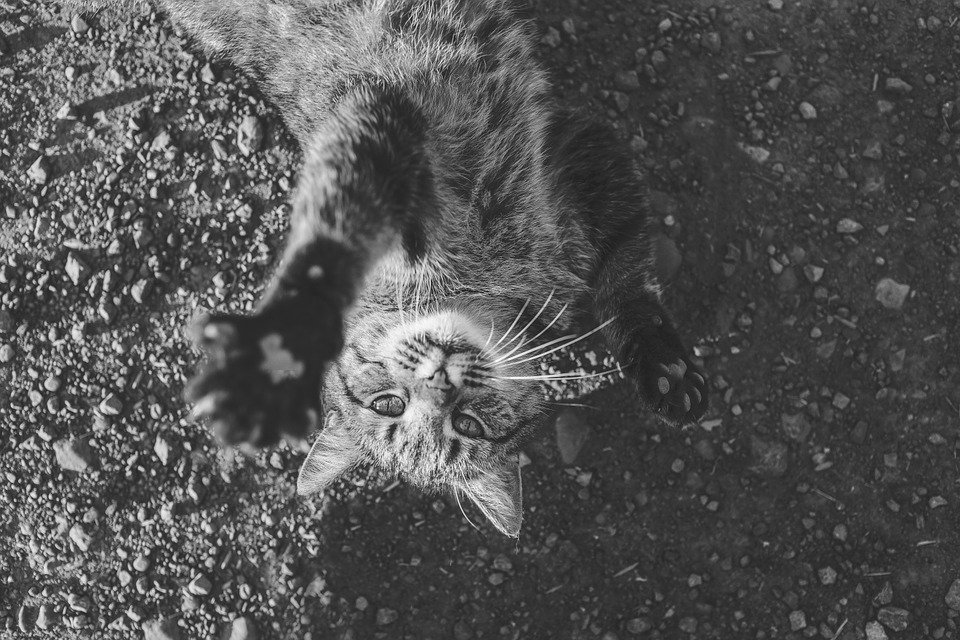This article unravels the intricate world of feline communication, focusing specifically on the act of hissing. We'll explore the various reasons behind this distinct vocalization, delving into the emotional states it reveals and the context in which it occurs. By understanding the nuances of a cat's hiss, we gain a deeper appreciation for their communication style and can build stronger bonds with our feline companions.
Part 1: Decoding the Hiss: A Comprehensive Guide

1. The Hiss: A Vocalization of Many Meanings
Cats are renowned for their complex communication system, relying heavily on body language, facial expressions, and a unique repertoire of vocalizations. The hiss, a sharp, forceful expulsion of air, stands out as a particularly versatile tool in their communication arsenal. It's a powerful signal that can convey a wide spectrum of emotions and intentions, from mild warning to outright aggression.
1.1. The Physics of the Hiss
The hiss is produced by a rapid exhalation of air from the lungs, forced through the mouth and over the tongue. This creates a distinctive, high-pitched sound that instantly grabs attention. The intensity of the hiss can vary, providing valuable clues about the cat's emotional state. A soft, gentle hiss often indicates a mild warning or a simple request for space, while a loud, aggressive hiss signals heightened anxiety or a potential threat.
2. The Hiss as a Warning Signal
The hiss serves as the cat's initial line of defense, a clear message to others (be it another cat, a human, or a dog) to back off. It's a warning, a way of saying, "Don't come any closer!" This warning can be interpreted as a request for space, a plea for respect, or a strategy to de-escalate a potentially confrontational situation.
2.1. Hissing as a Territorial Defense Mechanism
Cats are highly territorial creatures, and the hiss often plays a crucial role in defending their space. If another animal enters their territory, they may hiss to assert dominance and warn the intruder to retreat.
3. Unmasking the Triggers: Why Cats Hiss
The reasons behind a cat's hiss are as varied as their personalities. It's essential to consider the context and surrounding cues to interpret the hiss accurately.
3.1. Fear and Anxiety
Hissing frequently stems from fear or anxiety. If a cat feels threatened, overwhelmed, cornered, or surprised, it may hiss to express its distress and urge the perceived threat to back off.
3.2. Aggression and Defensive Behaviour
While the hiss is primarily a defensive mechanism, it can also be a sign of aggression. A cat may hiss to protect its territory, food, or its owner, particularly if it feels its resources are under threat.
3.3. Playful Hissing
Interestingly, hissing can sometimes be a playful behaviour. Kittens often hiss playfully with their littermates, and even adult cats may hiss during rough-and-tumble play sessions. These playful hisses are usually softer and less intense than those expressing fear or aggression.
4. Decoding the Hiss: Reading Body Language
A cat's body language provides crucial insights into the meaning behind its hiss. By carefully observing these nonverbal cues, you can gain a better understanding of its emotional state.
4.1. Tail Position
The tail is a key indicator of a cat's feelings. A tail held high and twitching often suggests playfulness or excitement. A tail tucked between the legs or swishing back and forth, however, indicates fear, anxiety, or aggression. A puffed-up tail, often accompanied by a hiss, signifies a heightened state of arousal and readiness to defend itself.
4.2. Ears
Ears play a significant role in feline communication. Ears held forward and alert usually indicate interest or playfulness. Flattened ears, on the other hand, signal fear, anxiety, or aggression. Ears that are flattened back against the head are a strong indicator of a cat preparing to fight.
4.3. Pupil Dilation
Pupil dilation can also provide clues. Dilated pupils often indicate fear, excitement, or aggression. Constriction of the pupils usually signifies a relaxed state.
4.4. Other Body Language Clues
Other body language clues can help interpret the hiss. A cat arching its back, fluffing its fur, and extending its claws are all signs of a threatened cat. A cat that is hissing and showing these additional cues is likely feeling very threatened and may be ready to attack if its perceived threat doesn't back down.
5. Responding to a Hissing Cat
When confronted with a hissing cat, remaining calm and respectful of its space is essential.
5.1. Respecting Boundaries
Avoid making direct eye contact and speak in a soothing, quiet voice. If you need to approach the cat, do so slowly and cautiously, allowing it to see you and assess the situation.
5.2. Addressing the Underlying Cause
Once the cat has calmed down, try to understand the reason for the hissing. If it's fear, identify the trigger and minimize exposure to it. If it's aggression, seeking professional help from a veterinarian or a certified cat behaviorist is advisable.
Part 2: Living Peacefully with a Hissing Cat

6. Creating a Calm Environment for Your Feline Friend
While hissing is a natural feline behaviour, creating a peaceful environment can minimize its occurrence.
6.1. Providing Safe Spaces
Ensure your cat has access to safe havens, like a comfortable bed or a high perch, where they can retreat when feeling overwhelmed. This allows them to feel secure and less likely to hiss as a defense mechanism.
6.2. Positive Reinforcement
Reward your cat's positive behaviour with treats, praise, and playtime. This helps build a strong bond and encourages peaceful interaction.
6.3. Minimising Stressors
Cats are sensitive creatures and can be stressed by environmental changes, like new pets, moving house, or even a change in furniture arrangement. Identify any potential stressors and address them appropriately.
7. Understanding the Root Cause: Medical and Behavioural Considerations
It's crucial to understand the root cause of your cat's hissing to address it effectively.
7.1. Medical Conditions
Hissing can sometimes be a symptom of a medical condition, such as hyperthyroidism, pain, or neurological issues. Consult a veterinarian to rule out any underlying health issues.
7.2. Behavioural Issues
If no medical condition is found, behavioural issues may be contributing to the hissing. These can include anxiety, fear, territoriality, or a lack of socialisation.
8. Seeking Professional Guidance: When to Call in the Experts
If you're struggling to manage your cat's hissing behaviour, don't hesitate to seek professional help.
8.1. Veterinarians
Veterinarians can diagnose any underlying medical conditions and provide guidance on behavioural management. They may also refer you to a certified cat behaviourist for specialized help.
8.2. Certified Cat Behaviorists
Certified cat behaviorists are trained professionals who can offer personalized behaviour modification plans tailored to your cat's specific needs. They can help identify the triggers for your cat's hissing and provide strategies to reduce stress and promote positive communication.
Part 3: FAQs: Answering Common Questions
1. Is hissing always a sign of aggression?
While hissing can indicate aggression, it's often a warning signal or a way to express fear or anxiety. It's crucial to look at the surrounding body language and context to interpret the hiss accurately.
2. Why do cats hiss at strangers?
Cats often hiss at strangers as a way to assert their territory and warn them to stay away. This is a natural defensive response, especially if the cat feels threatened or unfamiliar with the stranger.
3. Should I punish my cat for hissing?
Punishing your cat for hissing will only make it more fearful and anxious. Instead, try to understand the reason for the hissing and address the underlying issue.
4. How can I stop my cat from hissing at me?
The best way to prevent your cat from hissing at you is to create a safe and comfortable environment for them. Avoid sudden movements and loud noises, and provide them with plenty of space and attention. If the hissing persists, seek professional help from a veterinarian or a certified cat behaviorist.
5. Is hissing dangerous for humans?
While hissing is a powerful vocalization, it's not dangerous to humans. It's simply a way for cats to communicate their feelings and intentions. However, if the hissing is accompanied by aggression, it's best to seek professional help.
6. What should I do if my cat hisses at another cat?
If your cat hisses at another cat, try to separate them and provide them with separate spaces. If the hissing is persistent, seek professional help from a veterinarian or a certified cat behaviorist.
7. Can I train my cat to stop hissing?
It's unlikely that you can completely train your cat to stop hissing. However, you can create a safe and secure environment that reduces the likelihood of hissing. This includes providing safe spaces, positive reinforcement, and addressing any underlying medical or behavioural issues.
8. Why do cats hiss at mirrors?
Cats often hiss at mirrors because they see a reflection of themselves and perceive it as a threat. This is particularly common in cats who are not used to seeing their reflection or who have a tendency towards anxiety or fear.
9. Why do cats hiss when they are petted?
Some cats hiss when they are petted because they are overstimulated. They may be sensitive to touch in certain areas, or they may simply be feeling overwhelmed by the attention. Other cats may hiss because they are feeling possessive of their owner or their territory.
10. Why do cats hiss when they are eating?
Cats hiss when they are eating because they are protecting their food. This is a natural instinct that helps them to ensure that they have enough food to survive.
Everyone is watching

Are Cat Ribs Flexible? Understanding Their Anatomy
CATS & KITTENSThis article delves into the fascinating world of feline anatomy, exploring the flexibility of cat ribs and ho...

Can Cats Eat Bananas? (Everything You Need to Know)
CATS & KITTENSThis article dives into the intriguing question of whether cats can safely enjoy the sweet, yellow fruit, bana...

Cat Lifespan: How Long Do Cats Live?
CATS & KITTENSThis comprehensive guide explores the factors influencing the lifespan of our feline companions, providing ins...

Can Cats Get COVID-19? What You Need to Know
CATS & KITTENSThis article will delve into the fascinating world of feline COVID-19 susceptibility. We'll explore whether ca...

Can Cats Eat Eggs? A Complete Guide to Egg Safety for Your Feline Friend
CATS & KITTENSWhen it comes to treating our furry companions, we all want to ensure we're doing what's best for them. Eggs...
